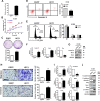Exosome-transmitted lncRNA UFC1 promotes non-small-cell lung cancer progression by EZH2-mediated epigenetic silencing of PTEN expression
- PMID: 32242003
- PMCID: PMC7118073
- DOI: 10.1038/s41419-020-2409-0
Exosome-transmitted lncRNA UFC1 promotes non-small-cell lung cancer progression by EZH2-mediated epigenetic silencing of PTEN expression
Abstract
Long non-coding RNAs (LncRNAs) have been suggested as important regulators of cancer development and progression in non-small cell lung cancer (NSCLC). Nevertheless, the biological roles and clinical significance of lncRNA UFC1 in NSCLC remain unclear. We detected the expression of UFC1 in tumor tissues, serum, and serum exosomes of NSCLC patients by qRT-PCR. Gene overexpression or silencing were used to examine the biological roles of UFC1 in NSCLC. RNA immunoprecipitation and ChIP assays were performed to evaluate the interaction between UFC1 and enhancer of zeste homolog 2 (EZH2) and the binding of EZH2 to PTEN gene promoter. Rescue study was used to access the importance of PTEN regulation by UFC1 in NSCLC progression. UFC1 expression was upregulated in tumor tissues, serum, and serum exosomes of NSCLC patients and high level of UFC1 was associated with tumor infiltration. UFC1 knockdown inhibited NSCLC cell proliferation, migration and invasion while promoted cell cycle arrest and apoptosis. UFC1 overexpression led to the opposite effects. Mechanistically, UFC1 bound to EZH2 and mediated its accumulation at the promoter region of PTEN gene, resulting in the trimethylation of H3K27 and the inhibition of PTEN expression. UFC1 knockdown inhibited NSCLC growth in mouse xenograft tumor models while the simultaneous depletion of PTEN reversed this effect. NSCLC cells derived exosomes could promote NSCLC cell proliferation, migration and invasion through the transfer of UFC1. Moreover, Exosome-transmitted UFC1 promotes NSCLC progression by inhibiting PTEN expression via EZH2-mediated epigenetic silencing. Exosome-mediated transmit of UFC1 may represent a new mechanism for NSCLC progression and provide a potential marker for NSCLC diagnosis.
Conflict of interest statement
The authors declare that they have no conflict of interest.
Figures







Similar articles
-
lncRNA ZEB2-AS1 Aggravates Progression of Non-Small Cell Lung Carcinoma via Suppressing PTEN Level.Med Sci Monit. 2019 Nov 7;25:8363-8370. doi: 10.12659/MSM.918922. Med Sci Monit. 2019. PMID: 31695021 Free PMC article.
-
Long non-coding RNA LINC01133 represses KLF2, P21 and E-cadherin transcription through binding with EZH2, LSD1 in non small cell lung cancer.Oncotarget. 2016 Mar 8;7(10):11696-707. doi: 10.18632/oncotarget.7077. Oncotarget. 2016. PMID: 26840083 Free PMC article.
-
Long noncoding RNA PCAT6 functions as an oncogene by binding to EZH2 and suppressing LATS2 in non-small-cell lung cancer.EBioMedicine. 2018 Nov;37:177-187. doi: 10.1016/j.ebiom.2018.10.004. Epub 2018 Oct 9. EBioMedicine. 2018. PMID: 30314898 Free PMC article.
-
Exosomal RNAs and EZH2: unraveling the molecular dialogue driving tumor progression.Med Oncol. 2025 Mar 12;42(4):103. doi: 10.1007/s12032-025-02648-x. Med Oncol. 2025. PMID: 40075013 Review.
-
The pharmacological and biological importance of EZH2 signaling in lung cancer.Biomed Pharmacother. 2023 Apr;160:114313. doi: 10.1016/j.biopha.2023.114313. Epub 2023 Feb 3. Biomed Pharmacother. 2023. PMID: 36738498 Review.
Cited by
-
LncRNA AL139294.1 can be transported by extracellular vesicles to promote the oncogenic behaviour of recipient cells through activation of the Wnt and NF-κB2 pathways in non-small-cell lung cancer.J Exp Clin Cancer Res. 2024 Jan 16;43(1):20. doi: 10.1186/s13046-023-02939-z. J Exp Clin Cancer Res. 2024. PMID: 38229152 Free PMC article.
-
Knockdown of lncRNA RMST protect against myocardial infarction through regulating miR-5692 and MAGI3 axis.Am J Transl Res. 2021 Apr 15;13(4):3906-3916. eCollection 2021. Am J Transl Res. 2021. PMID: 34017581 Free PMC article.
-
Emerging role of tumor-derived extracellular vesicles in T cell suppression and dysfunction in the tumor microenvironment.J Immunother Cancer. 2021 Oct;9(10):e003217. doi: 10.1136/jitc-2021-003217. J Immunother Cancer. 2021. PMID: 34642246 Free PMC article. Review.
-
The Disassociation of the A20/HSP90 Complex via Downregulation of HSP90 Restores the Effect of A20 Enhancing the Sensitivity of Hepatocellular Carcinoma Cells to Molecular Targeted Agents.Front Oncol. 2021 Dec 15;11:804412. doi: 10.3389/fonc.2021.804412. eCollection 2021. Front Oncol. 2021. PMID: 34976842 Free PMC article.
-
The Biological Roles of Exosomal Long Non-Coding RNAs in Cancers.Onco Targets Ther. 2021 Jan 12;14:271-287. doi: 10.2147/OTT.S281175. eCollection 2021. Onco Targets Ther. 2021. PMID: 33488093 Free PMC article. Review.
References
-
- Bray F, et al. Global cancer statistics 2018: GLOBOCAN estimates of incidence and mortality worldwide for 36 cancers in 185 countries. CA Cancer J. Clin. 2018;68:394–424. - PubMed
Publication types
MeSH terms
Substances
LinkOut - more resources
Full Text Sources
Medical
Research Materials

